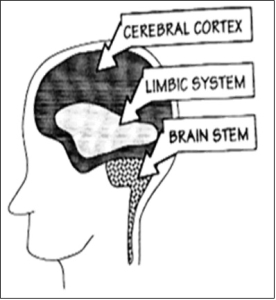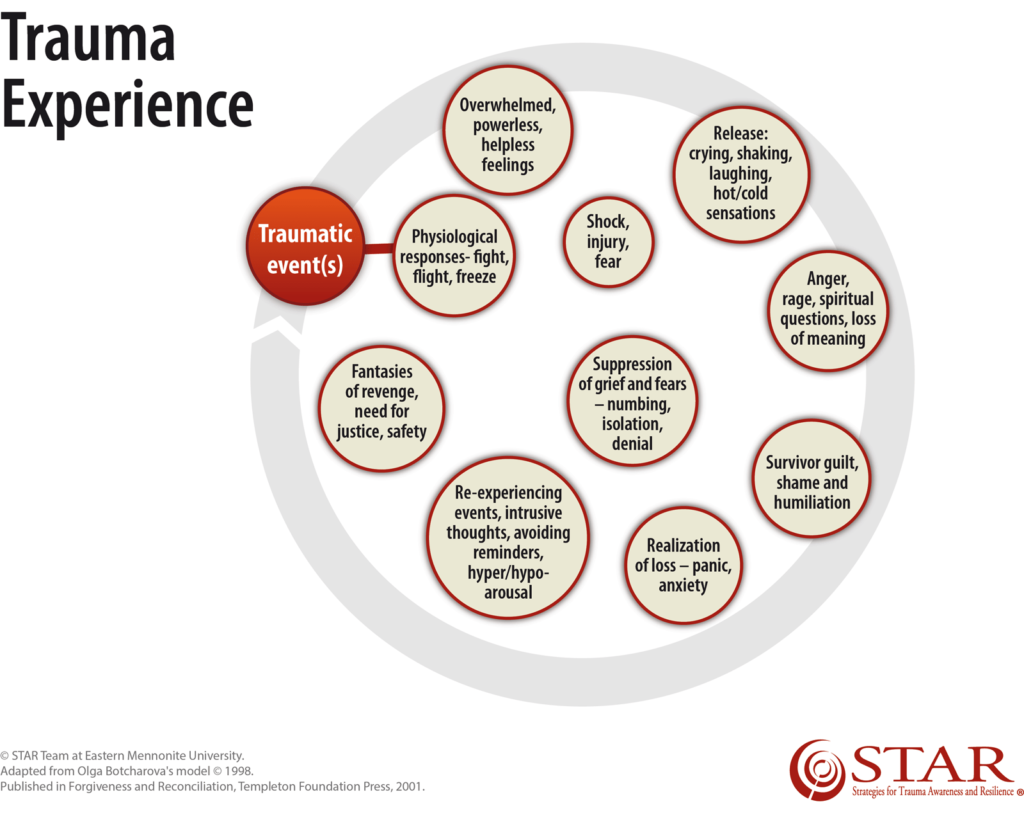Trauma Experience
How understanding normal responses to trauma helps you to help your community
When individuals, families, or your entire community have experienced trauma, you want to support them as effectively as possible. The first step to offering that support is to become trauma-informed. This means understanding what trauma is, and the normal physiological and psychological responses that follow it.
Trauma is a wound to the human body, mind, or spirit that overwhelms our usual ability to cope. It can affect individuals, communities, or an entire society.
In this page, you’ll find information about:
- Our natural physiological response to trauma
- The common psychological effects
- How to use this information to help people in your community address trauma
- Choices in how we respond
Our natural physiological trauma response
When something traumatic happens, our bodies immediately trigger a response that researchers call the “fight, flight, or freeze” response. This is an automatic physiological reaction that we humans share with most of the animal kingdom.

During this response, a cocktail of natural, energy-producing chemicals and hormones (e.g. adrenaline and cortisol) flood our bloodstream. The emotional and survival parts of our brains (the brain stem and limbic system) automatically take charge to help keep us alive.
Meanwhile, our slower-to-respond, rational, creative thinking area (the neo-cortex), which is less necessary for immediate survival, takes a “back seat.”
The effects of fight, flight, freeze
The sudden tornado of internal energy that we experience has a very specific physical purpose. It is designed to help us either fight off whatever caused the trauma, or run away from it.
 If we can fight or flee (or mimic the process, e.g. through physical release exercises), our rational brain, the neo-cortex, comes back online fairly quickly. This means that the different parts of our brain can work together in an integrated way, which helps us to start thinking more clearly again.
If we can fight or flee (or mimic the process, e.g. through physical release exercises), our rational brain, the neo-cortex, comes back online fairly quickly. This means that the different parts of our brain can work together in an integrated way, which helps us to start thinking more clearly again.
If, however, we can’t run away or fight—and we’re locked in a freeze response—this energy becomes trapped in our muscles, nervous system, and energy system. As long as it remains trapped there, our rational, creative thinking ability will remain impaired, which can make it difficult for us to:
- Extinguish irrational fear
- Connect with and feel empathy for others
- Be flexible in responding to new situations
- Make moral, ethical decisions
The diagram below shows common responses that happen after traumatic events. Remember that the physiological changes (the fight, flight, or freeze response) occur automatically and immediately.
The other reactions in the circles below can occur in any order—often in a confusing jumble—or not at all.
How to use this information to help people address trauma
1. If you’re working on the scene immediately after a traumatic event, focus on Psychological First Aid (PFA).
The information above on normal trauma responses helps you understand what is happening inside of people, whether they are upset or look calm. Psychological First Aid skills are also important if you’re working with people right after something happens. Just as physical first aid courses teach you what to do in a medical emergency, PFA courses teach you what to do in a traumatic situation: attending to safety needs, helping people locate loved ones, listening, identifying what they need next, etc.
Taking a PFA course before disaster strikes enables you to support your community when there is a crisis. You can find courses and information online. This guide is available in a number of languages.
2. Use the trauma experience diagram above to educate about normal trauma responses. When we know what normal trauma responses are, we feel a sense of relief. All the reactions in the diagram are normal at first. Knowing this helps people feel sane and less overwhelmed.
3. Use physical release tools to work with the torrent of emotions and energy. It’s normal to experience fear, pain, anger, and a desire to get revenge and “even the score,” especially if the traumatic event was deliberately caused. It’s also normal to feel powerless and helpless.
Physical release exercises are essential to release many of the body’s physical reactions to trauma, calm overwhelming emotions, and may even help prevent PTSD later. This in turn positively impacts our brain’s ability to function well, so we think more clearly. Learn which one works best for you and teach it to others.
4. Know the danger signs of unaddressed trauma. This is explained in the second part of the trauma diagram. Unaddressed trauma can ignite cycles of violence. Knowing how destructive unprocessed trauma reactions are can awaken in us the desire to find healthy ways to address our needs and to heal.
5. Take care of yourself. Don’t forget that if you’re in a helping role in the community or a helper from the outside, you may experience trauma reactions too. Just like in the airline safety videos, you need to “fit your own oxygen mask first” to serve effectively. If you care for yourself, you’ll be more able to lead in a way that helps to calm rather than inflames a tense situation.
Although it’s normal to feel overwhelmed, knowing we have choices in how to respond gives a sense of relief and control.
Individuals, communities, or even entire societies are at a crossroads in choosing how to respond after disaster. The decisions we make at these critical junctures can impact the future for years. The choices are:
Ignore the trauma, which often propels us into cycles of violence against ourselves and others, OR address the trauma and help prevent cycles of violence by using:
- Physical release exercises, which help to release the fight-flight-freeze reaction, re-establish their brain/body balance, and relieve many typical trauma reactions.
- Healing tools and processes, which help those affected to examine the meaning of what happened, seek justice in nonviolent ways, and identify and address the root causes.

